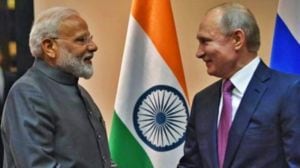Navy’s role in Lanka reflects shift in bilateral ties
That the Indian Navy could join the relief operations in Sri Lanka that bore the brunt of the tsunami strike is a reflection of the positive...

That the Indian Navy could join the relief operations in Sri Lanka that bore the brunt of the tsunami strike is a reflection of the positive state of current relations between New Delhi and Colombo as well as the level of mutual confidence between the two naval forces.
Relief operations being conducted by the Indian armed forces at home and abroad in the last couple of days are significant. But they reflect only one part of the role they could undertake in future disaster management.
Relief operations in the region could be far more effective, if there is greater contact between military establishments in the region, especially if there is advance preparation for such contingencies.
This can be done through joint exercises on disaster management between the Indian armed forces and their counterparts in the region. The US armed forces, at present, are the only ones who carry out such exercises on a sustained basis with the military forces in various parts of the world, including in our own neighbourhood.
But introducing foreign forces even in the most glaring of humanitarian circumstances is a difficult political proposition and needs a variety of prior arrangements. That is where frequent disaster management exercises help—both in facilitating inter-operability between regional military forces operating and in instituting well-understood and oft-practiced administrative procedures.
The role of the armed forces, however, goes beyond the mere management of consequences. It should include a much larger contribution in the predictive and preventive dimensions of disaster management.
Following the gigantic disaster, India is waking up to the need for modernising and expanding its infrastructure for surveillance of the Indian Ocean. The Navy is among the best positioned to play a crucial role in this future enterprise.
But the Navy, treated as stepchild of the Indian armed forces so obsessed with territorial defence even after acquiring nuclear weapons, needs resources to expand its on-shore and offshore technical capabilities to continuously monitor the Indian Ocean. The time has come to rapidly upgrade the existing survey and research capabilities of the Indian Navy.
Given the gigantic scale of the task of watching the Indian Ocean, historically under-monitored, cooperation with other naval forces is a necessity.
But much like the scientific establishment in India, the armed forces, too, have been forced into an isolationist mode since the mid 1960s. It is only since the early 1990s that regional engagement has come on to the Indian defence agenda.
Given its inherent nature, the Indian Navy has been quicker to adapt to international cooperation than the other two services.
The Navy at present has neither the resources nor the political direction to fulfill its natural role as a major provider of security, including humanitarian assistance, within the Indian Ocean littoral. Giving our Navy that new mandate and the necessary capabilities should be one of the important priorities for the Indian policy makers.
The Ministry of Defence, the Navy and the Foreign Office need to put in place a package of defence diplomacy that makes regional disaster management a major national military and strategic objective.
If Colombo had adopted the isolationist attitudes that refuse to go away in New Delhi, Indian Naval ships would not have been inside Sri Lankan ports, hours after the tsunami tragedy.




- 01
- 02
- 03
- 04
- 05



























